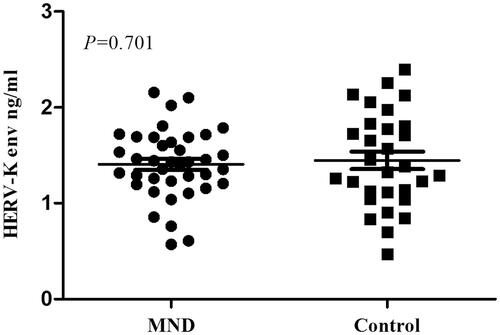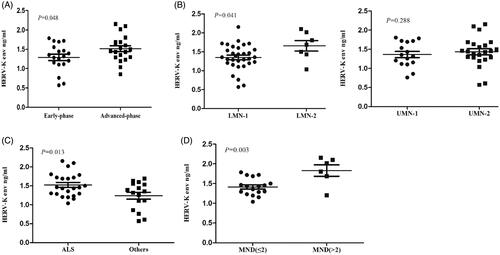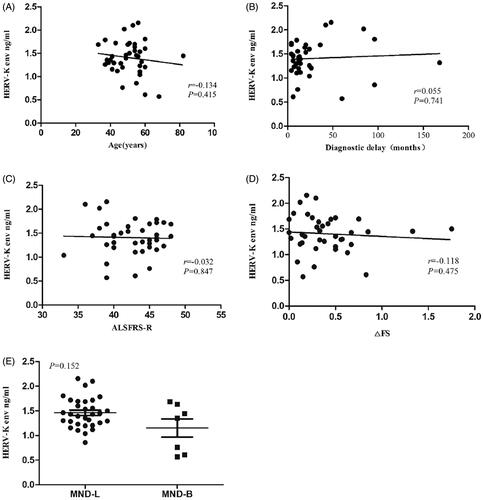Figures & data
Table 1 Characteristics of MND patients and controls.
Figure 1 HERV-K env level in the neuronal extracellular vesicles of MND patients and controls. The mean HERV-K env level in the neuronal extracellular vesicles of 39 MND patients was 1.41 (SD = 0.36) ng/ml, and that of the control group (n = 30) was 1.45 (SD =0.50) ng/ml. There was no significant difference between the groups (P = 0.701).

Figure 2 Analysis of HERV-K env level in the neuronal extracellular vesicles of MND patients. (A) The mean HERV-K env level in early-phase MND patients (n = 19) was lower than that in advanced-phase MND patients (n = 20) (p = 0.048). (B) Grouped by involved segments (bulbar, cervical, thoracic, lumbosacral), patients with affected motor neurons in no more than 2 segments were assigned to the LMN-1/UMN-1 groups, and those with 3–4 affected segments were assigned to the LMN-2/UMN-2 groups. The mean level of HERV-K env was positively associated with LMNs involved (p = 0.041). (C)The mean HERV-K env level in the ALS group was significantly higher than that in the other phenotype group (including 6 with FAS, 5 with FLS, and 5 with IBALS) (p = 0.013). (D)The mean level of HERV-K env in the patients with a disease course less than 2 years (MND ≤ 2) was significantly lower than that in the patients with a disease course more than 2 years (MND> 2) (p = 0.003).

Figure 3 Correlations between HERV-K env level in the neuronal extracellular vesicles and age, diagnostic delay time, ALSFRS-R score, ΔFS and the onset site. There were no significant correlations between HERV-K env and age (r=−0.134, 95% CI −0.420 to 0.156, p = 0.415) (A), diagnostic delay time (r = 0.055, 95% CI -0.294 to 0.442, p = 0.741) (B), ALSFRS-R score (r=−0.032, 95% CI −0.391 to 0.320, p = 0.847) (C), ΔFS (r=−0.118, 95% CI −0.418 to 0.191, p = 0.475) (D), the onset site (1.15, SD = 0.49;1.46, SD = 0.31, p = 0.152) (E).

Supplemental Material
Download MS Word (362.3 KB)Data availability statement
The data that support the findings of this study are available on request from the corresponding author. The data are not publicly available due to privacy or ethical restrictions.
